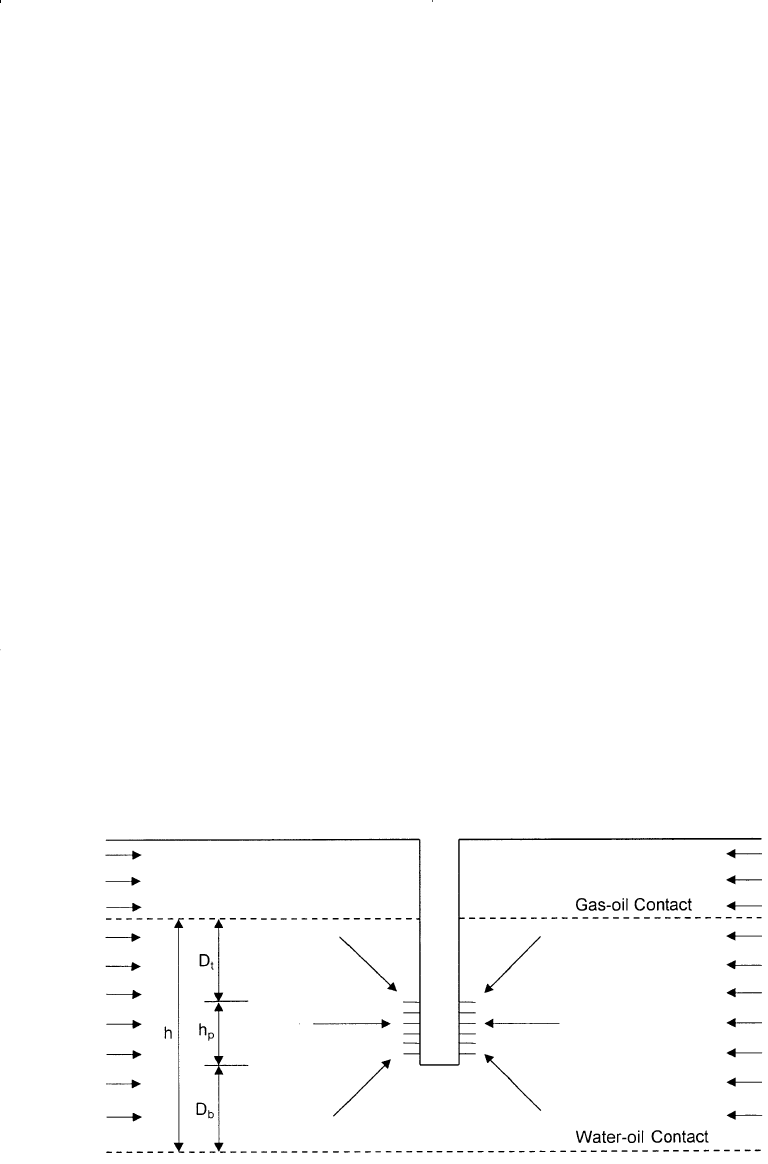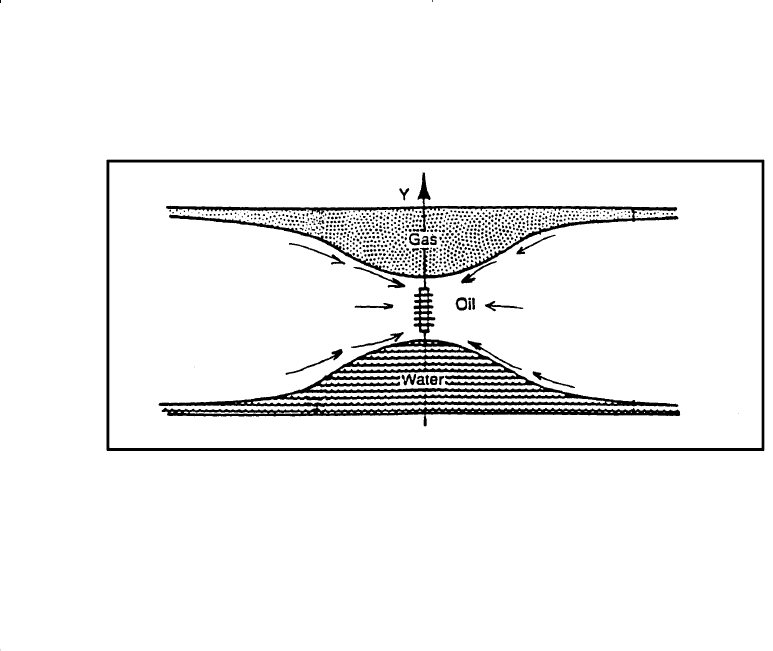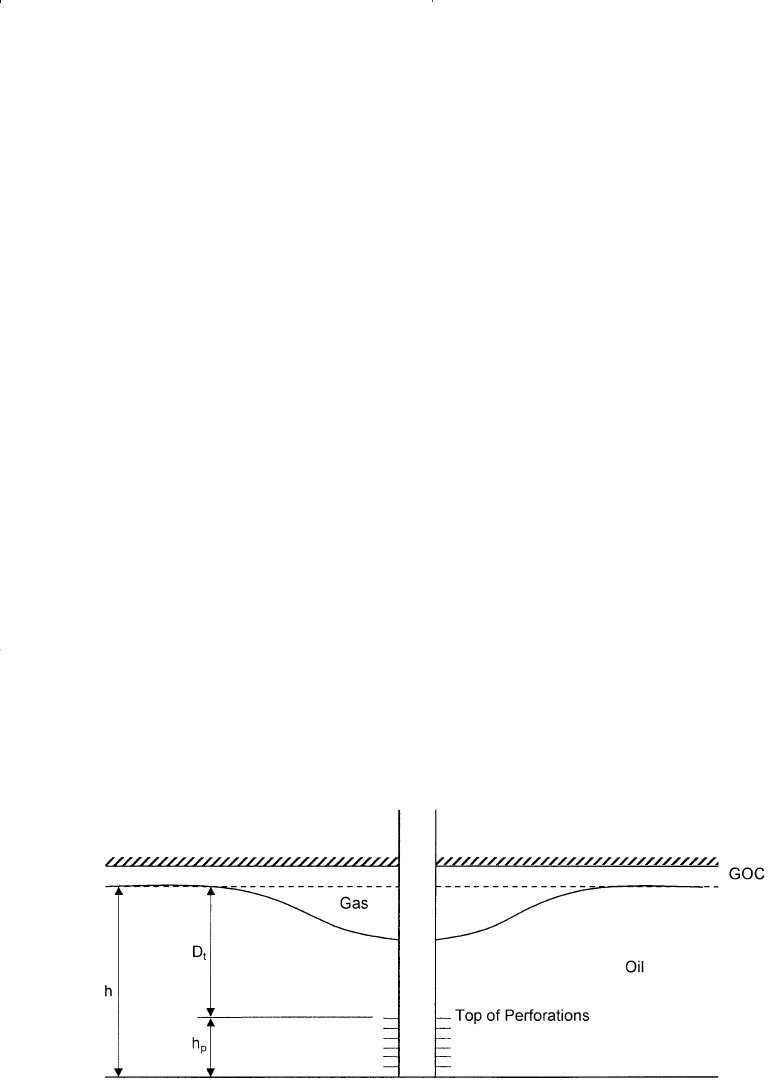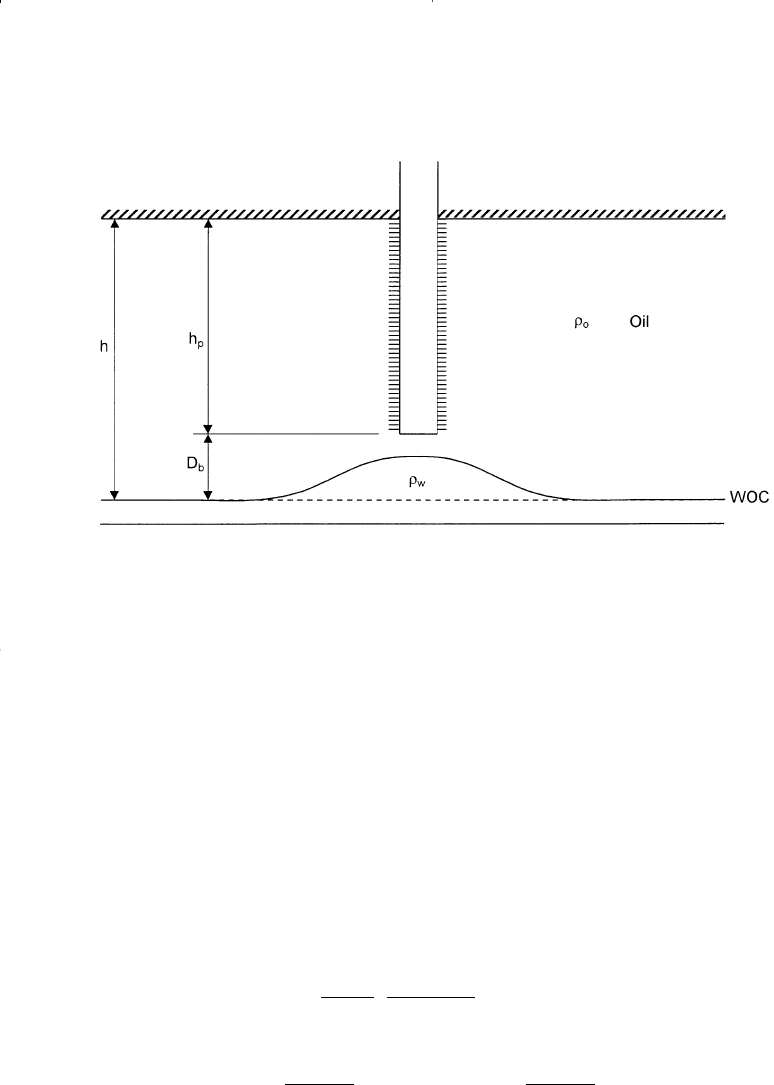Tarek Ahmed. Reservoir engineering handbook
Подождите немного. Документ загружается.


• Pressure-approximation approach
• Pseudopressure approach
b. Repeat part a for a future reservoir pressure of 4000 psi.
4. A 3,000-foot horizontal gas well is draining an area of approximately
180 acres, given:
p
i
= 2500 psi p
wf
= 1500 psi k = 25 md
T = 120°F r
w
= 0.25 h = 20 ft
u
g
= 0.65
Calculate the gas flow rate.
REFERENCES
1. Earlougher, Robert C., Jr., Advances in Well Test Analysis. Mongraph Vol. 5,
Society of Petroleum Engineers of AIME. Dallas, TX: Millet the Printer, 1977.
2. ERCB. Theory and Practice of the Testing of Gas Wells, 3rd ed. Calgary:
Energy Resources Conservation Board, 1975.
3. Fetkovich, M. J., “Multipoint Testing of Gas Wells,” SPE Mid-continent Sec-
tion Continuing Education Course of Well Test Analysis, March 17, 1975.
4. Golan, M., and Whitson, C., Well Performance. International Human
Resources Development Corporation, 1986.
5. Joshi, S., Horizontal Well Technology. Tulsa, OK: PennWell Publishing Com-
pany, 1991.
6. Lee, J., Well Testing. Dallas: Society of Petroleum Engineers of AIME, 1982.
7. Matthews, C., and Russell, D., “Pressure Buildup and Flow Tests in Wells.”
Dallas: SPE Monograph Series, 1967.
8. Rawlins, E. L., and Schellhardt, M. A., “Back-Pressure Data on Natural Gas
Wells and Their Application to Production Practices.” U.S. Bureau of Mines
Monograph 7, 1936.
568 Reservoir Engineering Handbook
Reservoir Eng Hndbk Ch 08 2001-10-24 11:13 Page 568

Coning is a term used to describe the mechanism underlying the
upward movement of water and/or the down movement of gas into the
perforations of a producing well. Coning can seriously impact the well
productivity and influence the degree of depletion and the overall recov-
ery efficiency of the oil reservoirs. The specific problems of water and
gas coning are listed below.
• Costly added water and gas handling
• Gas production from the original or secondary gas cap reduces pressure
without obtaining the displacement effects associated with gas drive
• Reduced efficiency of the depletion mechanism
• The water is often corrosive and its disposal costly
• The afflicted well may be abandoned early
• Loss of the total field overall recovery
Delaying the encroachment and production of gas and water are essen-
tially the controlling factors in maximizing the field’s ultimate oil recov-
ery. Since coning can have an important influence on operations, recov-
ery, and economics, it is the objective of this chapter to provide the
theoretical analysis of coning and outline many of the practical solutions
for calculating water and gas coning behavior.
569
CHAPTER 9
GAS AND WATER CONING
Reservoir Eng Hndbk Ch 09 2001-10-25 08:37 Page 569

CONING
Coning is primarily the result of movement of reservoir fluids in the
direction of least resistance, balanced by a tendency of the fluids to
maintain gravity equilibrium. The analysis may be made with respect to
either gas or water. Let the original condition of reservoir fluids exist as
shown schematically in Figure 9-1, water underlying oil and gas overly-
ing oil. For the purposes of discussion, assume that a well is partially
penetrating the formation (as shown in Figure 9-1) so that the production
interval is halfway between the fluid contacts.
Production from the well would create pressure gradients that tend to
lower the gas-oil contact and elevate the water-oil contact in the immedi-
ate vicinity of the well. Counterbalancing these flow gradients is the ten-
dency of the gas to remain above the oil zone because of its lower densi-
ty and of the water to remain below the oil zone because of its higher
density. These counterbalancing forces tend to deform the gas-oil and
water-oil contacts into a bell shape as shown schematically in Figure 9-2.
There are essentially three forces that may affect fluid flow distribu-
tions around the well bores. These are:
• Capillary forces
• Gravity forces
• Viscous forces
570 Reservoir Engineering Handbook
Figure 9-1. Original reservoir static condition.
Reservoir Eng Hndbk Ch 09 2001-10-25 08:37 Page 570

Capillary forces usually have negligible effect on coning and will be
neglected. Gravity forces are directed in the vertical direction and arise
from fluid density differences. The term viscous forces refers to the pres-
sure gradients associated fluid flow through the reservoir as described by
Darcy’s Law. Therefore, at any given time, there is a balance between
gravitational and viscous forces at points on and away from the well
completion interval. When the dynamic (viscous) forces at the wellbore
exceed gravitational forces, a “cone” will ultimately break into the well.
We can expand on the above basic visualization of coning by introduc-
ing the concepts of:
• Stable cone
• Unstable cone
• Critical production rate
If a well is produced at a constant rate and the pressure gradients in the
drainage system have become constant, a steady-state condition is
reached. If at this condition the dynamic (viscous) forces at the well are
less than the gravity forces, then the water or gas cone that has formed
will not extend to the well. Moreover, the cone will neither advance nor
recede, thus establishing what is known as a stable cone. Conversely, if
the pressure in the system is an unsteady-state condition, then an unsta-
ble cone will continue to advance until steady-state conditions prevail.
If the flowing pressure drop at the well is sufficient to overcome the
gravity forces, the unstable cone will grow and ultimately break into the
Gas and Water Coning 571
Figure 9-2. Gas and water coning.
Reservoir Eng Hndbk Ch 09 2001-10-25 08:37 Page 571

well. It is important to note that in a realistic sense, stable system cones
may only be “pseudo-stable” because the drainage system and pressure
distributions generally change. For example, with reservoir depletion, the
water-oil contact may advance toward the completion interval, thereby
increasing chances for coning. As another example, reduced productivity
due to well damage requires a corresponding increase in the flowing
pressure drop to maintain a given production rate. This increase in pres-
sure drop may force an otherwise stable cone into a well.
The critical production rate is the rate above which the flowing pres-
sure gradient at the well causes water (or gas) to cone into the well. It is,
therefore, the maximum rate of oil production without concurrent pro-
duction of the displacing phase by coning. At the critical rate, the built-
up cone is stable but is at a position of incipient breakthrough.
Defining the conditions for achieving the maximum water-free and/or
gas-free oil production rate is a difficult problem to solve. Engineers are
frequently faced with the following specific problems:
1. Predicting the maximum flow rate that can be assigned to a completed
well without the simultaneous production of water and/or free-gas.
2. Defining the optimum length and position of the interval to be perfo-
rated in a well in order to obtain the maximum water and gas-free pro-
duction rate.
Calhoun (1960) pointed out that the rate at which the fluids can come
to an equilibrium level in the rock may be so slow, due to the low perme-
ability or to capillary properties, that the gradient toward the wellbore
overcomes it. Under these circumstances, the water is lifted into the well-
bore and the gas flows downward, creating a cone as illustrated in Figure
9-2. Not only is the direction of gradients reversed with gas and oil
cones, but the rapidity with which the two levels will balance will differ.
Also, the rapidity with which any fluid will move is inversely proportion-
al to its viscosity, and, therefore, the gas has a greater tendency to cone
than does water. For this reason, the amount of coning will depend upon
the viscosity of the oil compared to that of water.
It is evident that the degree or rapidity of coning will depend upon the
rate at which fluid is withdrawn from the well and upon the permeability
in the vertical direction k
v
compared to that in the horizontal direction k
h
.
It will also depend upon the distance from the wellbore withdrawal point
to the gas-oil or oil-water discontinuity.
572 Reservoir Engineering Handbook
Reservoir Eng Hndbk Ch 09 2001-10-25 08:37 Page 572

The elimination of coning could be aided by shallower penetration of
wells where there is a water zone or by the development of better hori-
zontal permeability. Although the vertical permeability could not be less-
ened, the ratio of horizontal to vertical flow can be increased by such
techniques as acidizing or pressure parting the formation. The application
of such techniques needs to be controlled so that the effect occurs above
the water zone or below the gas zone, whichever is the desirable case.
This permits a more uniform rise of a water table.
Once either gas coning or water coning has occurred, it is possible to
shut in the well and permit the contacts to restabilize. Unless conditions
for rapid attainment of gravity equilibrium are present, restabilization
will not be extremely satisfactory. Fortunately, bottom water is found
often where favorable conditions for gravity separation do exist. Gas
coning is more difficult to avoid because gas saturation, once formed, is
difficult to eliminate.
There are essentially three categories of correlation that are used to
solve the coning problem. These categories are:
• Critical rate calculations
• Breakthrough time predictions
• Well performance calculations after breakthrough
The above categories of calculations are applicable in evaluating the
coning problem in vertical and horizontal wells.
CONING IN VERTICAL WELLS
Vertical Well Critical Rate Correlations
Critical rate Q
oc
is defined as the maximum allowable oil flow rate that
can be imposed on the well to avoid a cone breakthrough. The critical
rate would correspond to the development of a stable cone to an eleva-
tion just below the bottom of the perforated interval in an oil-water sys-
tem or to an elevation just above the top of the perforated interval in a
gas-oil system. There are several empirical correlations that are common-
ly used to predict the oil critical rate, including the correlations of:
• Meyer-Garder
• Chierici-Ciucci
• Hoyland-Papatzacos-Skjaeveland
Gas and Water Coning 573
Reservoir Eng Hndbk Ch 09 2001-10-25 08:37 Page 573

• Chaney et al.
• Chaperson
• Schols
The practical applications of these correlations in predicting the criti-
cal oil flow rate are presented over the following pages.
The Meyer-Garder Correlation
Meyer and Garder (1954) suggest that coning development is a result
of the radial flow of the oil and associated pressure sink around the well-
bore. In their derivations, Meyer and Garder assume a homogeneous sys-
tem with a uniform permeability throughout the reservoir, i.e., k
h
= k
v
. It
should be pointed out that the ratio k
h
/k
v
is the most critical term in eval-
uating and solving the coning problem. They developed three separate
correlations for determining the critical oil flow rate:
• Gas coning
• Water coning
• Combined gas and water coning
Gas coning
Consider the schematic illustration of the gas-coning problem shown
in Figure 9-3.
574 Reservoir Engineering Handbook
Figure 9-3. Gas coning.
Reservoir Eng Hndbk Ch 09 2001-10-25 08:37 Page 574

Meyer and Garder correlated the critical oil rate required to achieve a
stable gas cone with the following well penetration and fluid parameters:
• Difference in the oil and gas density
• Depth D
t
from the original gas-oil contact to the top of the perforations
• The oil column thickness h
The well perforated interval h
p
, in a gas-oil system, is essentially
defined as
h
p
= h - D
t
Meyer and Garder propose the following expression for determining
the oil critical flow rate in a gas-oil system:
where Q
oc
= critical oil rate, STB/day
r
g
, r
o
= density of gas and oil, respectively, lb/ft
3
k
o
= effective oil permeability, md
r
e
, r
w
= drainage and wellbore radius, respectively, ft
h = oil column thickness, ft
D
t
= distance from the gas-oil contact to the top of the
perforations, ft
Water coning
Meyer and Garder propose a similar expression for determining the crit-
ical oil rate in the water coning system shown schematically in Figure 9-4.
The proposed relationship has the following form:
where r
w
= water density, lb/ft
3
h
p
= perforated interval, ft
oc
4
wo
e
w
o
o
o
p
Q
= 0.246
10
(
r
/
r
)
k
B
hh¥
-
È
Î
Í
˘
˚
˙
Ê
Ë
Á
ˆ
¯
˜
-
-
rr
m
ln
()
22
(9 - 2)
oc
4
og
ew
o
o
o
2
t
Q
= 0.246
10
(
r
/
r
)
k
B
h
hD
¥
-
È
Î
Í
˘
˚
˙
Ê
Ë
Á
ˆ
¯
˜
-
-
[]
-
rr
m
ln
()
2
(9 -1)
Gas and Water Coning 575
Reservoir Eng Hndbk Ch 09 2001-10-25 08:37 Page 575

Simultaneous gas and water coning
If the effective oil-pay thickness h is comprised between a gas cap and
a water zone (Figure 9-5), the completion interval h
p
must be such as to
permit maximum oil-production rate without having gas and water
simultaneously produced by coning, gas breaking through at the top of
the interval and water at the bottom.
This case is of particular interest in the production from a thin column
underlaid by bottom water and overlaid by gas.
For this combined gas and water coning, Pirson (1977) combined
Equations 9-1 and 9-2 to produce the following simplified expression for
determining the maximum oil-flow rate without gas and water coning:
oc
4
o
o
o
2
p
ew
wo
og
wg
og
og
wg
Q
= 0.246
10
k
B
h
h
(
r
/
r
)
() () 1
¥
È
Î
Í
˘
˚
˙
-
¥
-
-
-
Ê
Ë
Á
ˆ
¯
˜
+- -
-
-
Ê
Ë
Á
ˆ
¯
˜
È
Î
Í
Í
˘
˚
˙
˙
-
m
rr
rr
rr
rr
rr
rr
2
22
ln
(9 - 3)
576 Reservoir Engineering Handbook
Figure 9-4. Water coning.
Reservoir Eng Hndbk Ch 09 2001-10-25 08:37 Page 576

Example 9-1
A vertical well is drilled in an oil reservoir overlaid by a gas cap. The
related well and reservoir data are given below:
horizontal and vertical permeability, i.e., k
h
, k
v
= 110 md
oil relative permeability, k
ro
= 0.85
oil density, r
o
= 47.5 lb/ft
3
gas density, r
g
= 5.1 lb/ft
3
oil viscosity, m
o
= 0.73 cp
oil formation volume factor, B
o
= 1.1 bbl/STB
oil column thickness, h = 40 ft
perforated interval, h
p
= 15 ft
depth from GOC to top of perforations, D
t
= 25 ft
wellbore radius, r
w
= 0.25 ft
drainage radius, r
e
= 660 ft
Using the Meyer and Garder relationships, calculate the critical oil
flow rate.
Solution
The critical oil flow rate for this gas-coning problem can be deter-
mined by applying Equation 9-1. The following two steps summarize
Meyer-Garder methodology:
Gas and Water Coning 577
Figure 9-5. The development of gas and water coning.
Reservoir Eng Hndbk Ch 09 2001-10-25 08:37 Page 577
